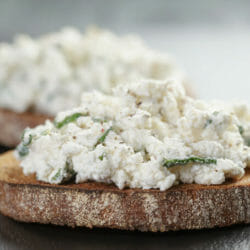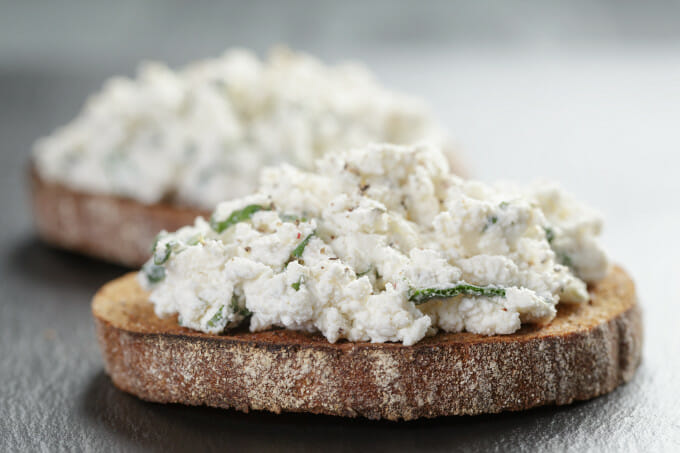Little Miss Muppet was onto a good thing. I didn’t know just how good until I sampled curds and whey for myself after eyeballing a recipe about how to make ricotta (the curds part of the equation). I made a batch. Then another. Followed by a double batch. And then I made smoothies with the leftover whey from all that cheese making. It seemed wrong to keep all this goodness to myself, so I taught the kids in my cooking class to make ricotta. And now here I am telling you.
If I’m not careful, I’ll be slapped with a lawsuit by Sorrento or Polly-O or Calabro for imploring the public at large to make, not buy, ricotta.
Since I’m risking my life savings here, let me tell you a few reasons why you might want to make ricotta.
1. Eating still-warm, just-made fresh cheese on toasted bread topped with olive oil and coarse salt is one of the best things you can do for yourself. It heals everything from heartache to hot flashes. Really.
2.. It’s crazy easy. Easier than figuring out which brand of ricotta to buy in the market.
3. It’s fun kitchen science. You and your kids can geek out over a pot of hot milk.
4. It just may convert a ricotta hater to a ricotta liker or a ricotta liker to a ricotta lover. This happened before my very eyes.Twice.
Don’t be scared. All that’s involved is boiling milk, adding lemon juice, waiting for curds and whey to separate, and straining.
You might be surprised that a whole quart of milk only makes about one cup of ricotta, which is why you need to hang onto the precious whey that’s left behind. It can sub in for water when making oatmeal, rice, and other grains. It also makes a tangy, low-calorie, low-fat vehicle for whirling up smoothies.

HOMEMADE RICOTTA
Ingredients
- 1 quart whole milk (pasteurized milk is ok, don't use UHT milk -- see Note)
- 1/4 cup fresh lemon juice
- Pinch salt
Instructions
-
Pour the milk into a medium saucepan. Set over medium-high heat and heat until the milk is just shy of a boil, stirring occasionally. Don't worry if it starts to boil a little. Remove from heat and add the lemon juice and salt. Stir gently a couple of times and watch the curds separate from the whey. Set aside for about 5 minutes.
-
Lay a piece of cheesecloth or a fine tea towel into a strainer set inside a large bowl. Pour the curds and whey into the cheesecloth and allow the liquid to drain for a few minutes. Lift the cheesecloth up by the edges, allowing any remaining liquid to strain out. I like a soft, moist curd so I refrain from squeezing the cloth too much. For dryer ricotta, squeeze away.
-
Transfer ricotta to a bowl and use immediately or cover and store in the refrigerator. Pour leftover whey into a pitcher and keep in the fridge.
-
Ricotta is best eaten within a day or two of being made, but will keep up to 1 week.
Recipe Notes
UHT refers to Ultra High Temperature pasteurization, whereby milk is heated to a much higher temperature than traditional pasteurization. This process prevents the curds and whey from separating.
Inspired by the Edible Schoolyard and the cookbook Yummy Supper
